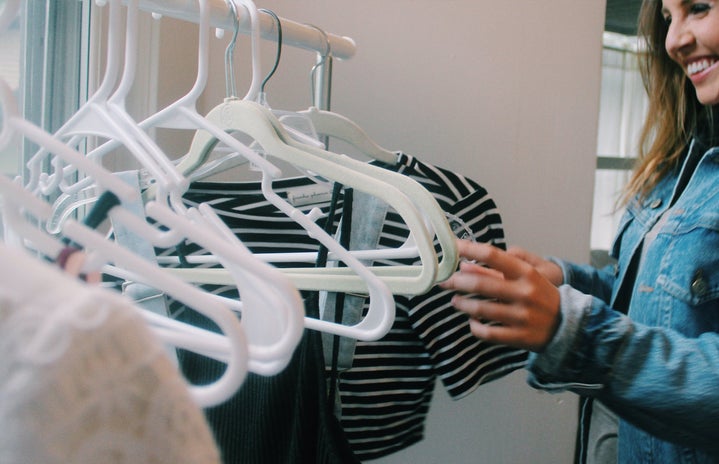What Is Eco-Fashion?
Eco-fashion, or sustainable fashion, is a movement that marries style with sustainability. Eco-fashion aims to fight against the staggering amount of waste created from clothing production and cultural materialism by reusing clothing and practising environmentally-friendly manufacturing.
Designers used to adopt the ‘fast fashion’ mentality, which means the industry should quickly produce clothing to keep up with trends. Now, the eco-fashion movement has shifted designers’ focus to think towards a more sustainable world for the fashion industry.
Why Do We Need It?
With the rise of globalization and the need to make clothing at an ever increasing pace to stay competitive, the fashion industry has never been bigger.
A 2017 report named Pulse of the Fashion Industry by Global Fashion Agenda echoes the idea that consumerism is growing. By 2030, the report projects apparel consumption will rise by 63 per cent from 62 million tonnes in 2017 to 102 million tonnes in 2030. The same report states the fashion industry’s carbon dioxide emissions may increase to 2.8 billion tonnes per year by 2030, which is the equivalent carbon effect of 230 million passenger vehicles driven for a year.
A rise in fashion consumption comes with severe environmental consequences, which makes supporting the eco-fashion movement even more important.
How Can You Support Eco-Fashion?
Know Your Brands
Supporting eco-fashion doesn’t mean your style has to suffer! One of the simplest ways to be an eco-conscious shopper is to be aware of which brands you buy from.
Researching the company before going into the store will help you navigate which brands you do and don’t want to support. One easy way to research is to look on the brand’s company website under “Corporate Responsibility.” Companies include their social and environmental goals, as well as their actions towards achieving these goals as part of their contribution to sustainble fashion.
If you still don’t know which brands to support after doing your research, take a look at the clothing label. Organic, vegan, Fairtrade, or recycled material certifications on labels are great signifiers of how eco-friendly the item and its producers are.
Get Thrifty
Need an excuse to go out thrifting with your friends? Eco-fashion has you covered! Vintage is all the rage right now and not only is it a more affordable way to get brand name designs, but it’s also a great way to keep clothes that are in great condition out of landfills.
According to a 2018 report by Quantis called Measuring Fashion: Insights from the Environmental Impact of the Global Apparel and Footwear Industries study, a person on average consumes 11.4kg of apparel each year. By buying pre-loved clothes at a vintage or thrift store, you can cut down on your fashion consumption without sacrificing the fun of new clothes.
Make a day out of thrifting by going out with all of your friends, taking Insta photos in the craziest vintage styles, and scouring the racks together for the best finds.
Step Up Your Style Game
We’re all guilty of looking into our closets full of clothes and saying we have nothing to wear.
In a 2017 report titled A New Textiles Economy: Redesigning Fashion’s Future by the Elle MacArthur Foundation, the average number of times a garment is worn before it is discarded has decreased by 36 per cent in the past 15 years, which means we’re wearing our clothes less and replacing them more often.
It’s time to reimagine our personal lookbooks and switch up how we style our clothes. Investing in staple pieces that can be styled different ways, rather than trendy styles that are more difficult to wear, allows you to get more versatility out of your outfits.
Another chic tip to consider is wearing pieces beyond their designated style season. This is a favourite among fashion bloggers, who layer long sleeve shirts under summer dresses to transition into a fall outfit. You can show off your creativity by reimagining your go-to outfits, while reducing your fashion consumption in the process.
Start Swapping
Clothes swapping can go beyond lending your BFF a cute skirt to wear on girl’s night. To do a clothes swap, get a group of friends together, go through your closets for pieces you don’t like or don’t wear often, and trade with each other for a “whole new” wardrobe. Aside from clearing out clothes from your closet, you could also find some great finds without spending a cent! Clothes swaps can be especially fun if friends have different styles, because you never know when one girl’s frock will be another’s little black dress. To turn the event into a girl’s day, just add drinks and snacks!
Not sure your friends would be willing to part with some of their clothes? There are also community clothes swaps and websites, like meetup.com, that can help you connect with other eco-savvy shoppers just like you. Broadening your fashion-swap circle will give you greater diversity in the clothing options you have to choose from and the added bonus of meeting new friends.
Pick Up A Needle And Thread
Whether the thigh of your favourite jeans just ripped or the button on your new jacket just fell off, sewing is a great way to fix small issues of wear and tear without having to throw out the best pieces in your closet. Even though less people know how to sew today than previous generations, just like with any hobby, anyone can learn with practise.
Being able to make small alterations and amendments for yourself will cut down on the need to replace garments and let your most stylish pieces last, saving money and the environment at the same time.
Even if you don’t know how to sew yourself, find a friend or family member who does. Not only will they be able to show you how to mend your clothes, but you’ll get the added bonus of spending quality time together. Don’t know anyone who knows how to sew? Another great option for mending clothes is getting in touch with your local seamstress or tailor.
Overall, style doesn’t have to be sacrificed in order to support eco-fashion. You don’t need to give up on trends or completely change how you shop. Even little decisions, like supporting ethical brands or sewing up a tear make a difference. Just as fashion is a vehicle for self-expression, let eco-fashion be the channel for a chic world.


